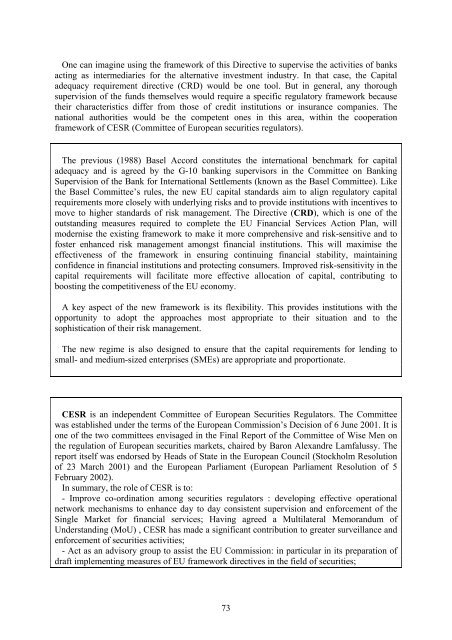Executive summary - Udo Bullmann
Executive summary - Udo Bullmann
Executive summary - Udo Bullmann
- No tags were found...
You also want an ePaper? Increase the reach of your titles
YUMPU automatically turns print PDFs into web optimized ePapers that Google loves.
One can imagine using the framework of this Directive to supervise the activities of banksacting as intermediaries for the alternative investment industry. In that case, the Capitaladequacy requirement directive (CRD) would be one tool. But in general, any thoroughsupervision of the funds themselves would require a specific regulatory framework becausetheir characteristics differ from those of credit institutions or insurance companies. Thenational authorities would be the competent ones in this area, within the cooperationframework of CESR (Committee of European securities regulators).The previous (1988) Basel Accord constitutes the international benchmark for capitaladequacy and is agreed by the G-10 banking supervisors in the Committee on BankingSupervision of the Bank for International Settlements (known as the Basel Committee). Likethe Basel Committee’s rules, the new EU capital standards aim to align regulatory capitalrequirements more closely with underlying risks and to provide institutions with incentives tomove to higher standards of risk management. The Directive (CRD), which is one of theoutstanding measures required to complete the EU Financial Services Action Plan, willmodernise the existing framework to make it more comprehensive and risk-sensitive and tofoster enhanced risk management amongst financial institutions. This will maximise theeffectiveness of the framework in ensuring continuing financial stability, maintainingconfidence in financial institutions and protecting consumers. Improved risk-sensitivity in thecapital requirements will facilitate more effective allocation of capital, contributing toboosting the competitiveness of the EU economy.A key aspect of the new framework is its flexibility. This provides institutions with theopportunity to adopt the approaches most appropriate to their situation and to thesophistication of their risk management.The new regime is also designed to ensure that the capital requirements for lending tosmall- and medium-sized enterprises (SMEs) are appropriate and proportionate.CESR is an independent Committee of European Securities Regulators. The Committeewas established under the terms of the European Commission’s Decision of 6 June 2001. It isone of the two committees envisaged in the Final Report of the Committee of Wise Men onthe regulation of European securities markets, chaired by Baron Alexandre Lamfalussy. Thereport itself was endorsed by Heads of State in the European Council (Stockholm Resolutionof 23 March 2001) and the European Parliament (European Parliament Resolution of 5February 2002).In <strong>summary</strong>, the role of CESR is to:- Improve co-ordination among securities regulators : developing effective operationalnetwork mechanisms to enhance day to day consistent supervision and enforcement of theSingle Market for financial services; Having agreed a Multilateral Memorandum ofUnderstanding (MoU) , CESR has made a significant contribution to greater surveillance andenforcement of securities activities;- Act as an advisory group to assist the EU Commission: in particular in its preparation ofdraft implementing measures of EU framework directives in the field of securities;73





